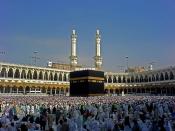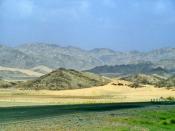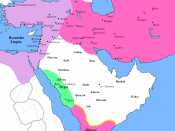In Arabia, the period before the emergence of Muhammad was a time of many different and varying religious practices.
To understand the religious beliefs and practices of the time, it is necessary first to have some basic appreciation of Arabia as a whole. The Arabian Peninsula can be divided into two distinct climactic and geographical zones: North and South. In the South was an area along the coast of the Arabian Sea that received regular rain and was heavily populated by sedentary populations living in cities and relying on agriculture. North of this area was one of the most inhospitable areas in the world. Its arid environment and rare precipitation meant that agriculture was impossible. Thus, the inhabitants of this harsh area lived in a Nomadic tribal existence, wandering with their animals in search of water and scarce resources. Despite this, there were 'towns' that developed around certain oases, and some tribes grew more settled here amongst the resources; although which specific tribe was settled there was often a cause for inter-tribal conflict and competition.
Such towns became trade centres, as the main economy of Arabia was trade between South and North. The greatest example of this was Mecca: the centre of Arabian commerce owing to its prime location on the caravan routes and, as the name suggests (which means 'temple) the centre of pre-Islamic religious worship.
The majority of Arabs did not belong to any formal religion but believed in a combination of supernatural forces, some of which they identified as spirits and others as Gods. This is known as Bedouin polytheism. The spirits were believed to inhabit natural objects such as rocks and trees and to have influence of human lives, whereas the gods were often identified with natural phenomena such as the sun, moon and rain. Many...


